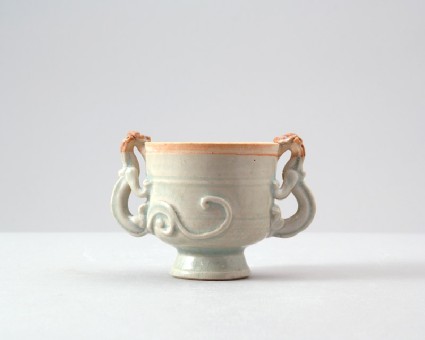The Barlow Collection
A select catalogue of the Barlow collection of Chinese Ceramics, Bronzes and Jades by the University of Sussex (published Sussex, 2006).

Publications online: 456 objects
White ware cup with two dragons
- loan
-
Literature notes
This shape, with dragons curling around the vessel and forming the handles, was also popular in jade and in bronze.
The deep cup has nearly straight sides and a splayed foot. Two freely modelled dragons are attached on either side as handles, their long scrolling tails curling round the cup, their mouths biting the rim, their claws resting on its sides. Their heads are moulded with protruding eyes, eyebrows and snout, the ears are separately attached, manes incised and prominent spines applied. The vessel is covered with a blue-tinged transparent glaze, except for the rim and the heads of the dragons, which have turned a light brick-red. The piece was fired upside down. -
Details
- Associated place
-
Asia › China › Jiangxi province › Jingdezhen › Jingdezhen kilns (place of creation)
- Date
-
13th century (1201 - 1300)
Southern Song Dynasty (1127 - 1279)
- Material and technique
- porcelain, thrown, with moulded decoration under a bluish-white glaze (qingbai ware); handles hand-modelled and luted to the cup with slip; glazed base; unglazed rim
- Dimensions
- 8.1 x 11.5 x 7.5 cm (height x width x depth)
- Material index
- Technique index
- Object type index
- No. of items
- 1
- Credit line
- Lent by the Sir Alan Barlow Collection Trust.
- Accession no.
- LI1301.249
-
Further reading
University of Sussex, and Arts and Humanities Research Council, The Barlow Collection, supervised by Regina Krahl, Maurice Howard, and Aiden Leeves (Sussex: University of Sussex, 2006), no. C240
Glossary (4)
glaze, luted, porcelain, slip
-
glaze
Vitreous coating applied to the surface of a ceramic to make it impermeable or for decorative effect.
-
luted
The fusion of parts of ceramics using dilute clay slip.
-
porcelain
Ceramic material composed of kaolin, quartz, and feldspar which is fired to a temperature of c.1350-1400⁰c. The resulting ceramic is vitreous, translucent, and white in colour.
-
slip
A semi-fluid clay applied to a ceramic before glazing either to coat the surface or for decorative effect.
Location
-
- currently in research collection
Objects are sometimes moved to a different location. Our object location data is usually updated on a monthly basis. Contact the Jameel Study Centre if you are planning to visit the museum to see a particular object on display, or would like to arrange an appointment to see an object in our reserve collections.
Publications online
-

The Barlow Collection
This shape, with dragons curling around the vessel and forming the handles, was also popular in jade and in bronze.
The deep cup has nearly straight sides and a splayed foot. Two freely modelled dragons are attached on either side as handles, their long scrolling tails curling round the cup, their mouths biting the rim, their claws resting on its sides. Their heads are moulded with protruding eyes, eyebrows and snout, the ears are separately attached, manes incised and prominent spines applied. The vessel is covered with a blue-tinged transparent glaze, except for the rim and the heads of the dragons, which have turned a light brick-red. The piece was fired upside down.
Notice
Object information may not accurately reflect the actual contents of the original publication, since our online objects contain current information held in our collections database. Click on 'buy this publication' to purchase printed versions of our online publications, where available, or contact the Jameel Study Centre to arrange access to books on our collections that are now out of print.
© 2013 University of Oxford - Ashmolean Museum




